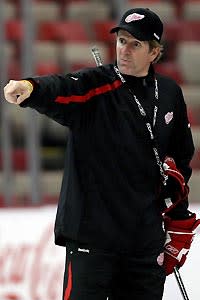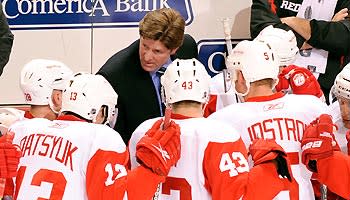The passion still there for Wings’ Babcock
DETROIT – Mike Babcock was the first one at the rink Monday, as usual. He arrived at Joe Louis Arena about 6:30 a.m., even though his Detroit Red Wings weren’t practicing until 11. He watched video – lots of video. Ask anyone about Babcock, and they’ll say he’s prepared.
“I think stats-wise and players-wise and team-wise, he reminds me of Scotty a bit,” said goaltender Chris Osgood(notes), comparing him to legend Scotty Bowman. “He knows everybody. He knows all the teams. He’s a real good X’s and O’s guy. …
“He’s demanding, and I don’t want to say obsessed with hockey – that sounds crazy – but close to it.”
It should be no surprise, then, that as Babcock was considering signing a contract extension with the Wings, he did his homework.
Babcock had talked to Bowman, whose nine-year run as coach of the Wings had ended three years before his arrival in 2005-06. But he wanted to know more about what it was like to coach in one place for a long period of time.
So he called the two longest-tenured coaches in the NHL: Lindy Ruff, who is in his 13th season with the Buffalo Sabres, and Barry Trotz, who is in his 12th with the Nashville Predators. But he still wasn’t satisfied.
And so he also called Dave Tippett, who is in his second season with the Phoenix Coyotes after six with the Dallas Stars. He asked if it was better to go somewhere new and start fresh.
Was he worried his message would go stale in Detroit?
“I think you’re always worried,” Babcock said. “Anytime you lose a game, you wonder why you lost.”
The thing is, the Wings haven’t lost much.
The NHL’s Big Red Machine has made the playoffs for 19 consecutive seasons and won four Stanley Cups since 1997, coming within a game of winning a fifth. The Wings remain a top contender this season and could remain one for years to come under Babcock. They announced Monday that he has signed a four-year extension, locking him up through 2014-15.
“I think when it gets stale, you’ll worry about it at that point in time,” said general manager Ken Holland, who signed a five-year extension himself over the summer, along with assistant GM Jim Nill. “Right now it’s not stale.”
Critics have been calling the Red Wings old for so long, the label has gotten old. The Wings have a significant veteran presence on their roster, but it’s partly by necessity, partly by design and often misunderstood.
The Wings are fighting the inertia of professional sports. The system is designed for the top teams to fade and bottom teams to improve. The Wings haven’t bottomed out, so they haven’t been able to restock their talent with high draft picks, like the Pittsburgh Penguins, Washington Capitals and Chicago Blackhawks have, like the Edmonton Oilers hope they have. Thanks to winning – and to trading draft picks in an effort to win – the Wings’ average first pick over the past decade has been 48th overall. They have had to change on the fly, hitting on lower picks, acquiring veterans.
Holland believes in bringing along players slowly, anyway. He spent years as a minor-league goaltender, watching excited teammates go up to the show, only to come back with their confidence crushed. He also has built a team that plays a puck-possession style, which relies on experience and intelligence as much as speed and skill. He lets his youngsters ripen until they are ready – until they are more than ready – and when his youngsters finally enter the NHL, their development is really just beginning. The Wings have a strong culture of mentoring.
“It’s always a cycle of three – the older guys, the middle of the pack and the young guys coming up,” said Osgood, who has come full circle in two tours with the Wings, going from young kid to old sage. “It’s always that cycle where you just switch spots. It’s always when they get to that certain spot, they’re always really prepared and ready for that stage of their career, 100% prepared. That’s what makes it so successful. You have nobody in a spot that’s not ready for that.”
Yes, the Wings have eight players who are 35 and older. But take a closer look:
Defenseman Nicklas Lidstrom(notes) and center Mike Modano(notes) are 40. But even at less than his best, Lidstrom is still one of the best in the league. Modano is not a No. 1 center; he’s a No. 3.
Center Kris Draper(notes) is 39, but his role is to provide depth and leadership. Defenseman Brian Rafalski(notes) is 37, but the hope is that his savvy will offset whatever has slowed. Forward Tomas Holmstrom(notes) is 37, but his game always has been about parking in front of the net, never about skating. Osgood is 37, but he’s the backup, not the starter. Winger Todd Bertuzzi(notes) and defenseman Ruslan Salei(notes) are 35, but they should have enough tread left to play their roles.
The Wings have several players in their prime, including forwards Pavel Datsyuk(notes), 32, Johan Franzen(notes), 30, Henrik Zetterberg(notes), 29, and Valtteri Filppula(notes), 26; defenseman Niklas Kronwall(notes), 29; and goaltender Jimmy Howard(notes), 26. They also have young players like forwards Justin Abdelkader(notes) and Darren Helm(notes) and defenseman Jakub Kindl(notes), each of whom is 23.
Which brings us back to Babcock. It takes a certain kind of coach to reach all three types of players and keep such a program humming.
Babcock has covered the spectrum. He has led the elite of the elite, winning gold with Team Canada at the 2010 Vancouver Olympics. But his roots are in Canadian university and junior hockey. This is a man who, for big games, wears a tie from McGill University, where he earned a degree in physical education and attended graduate school in sports psychology. He has no interest in being a general manager. What will he do when he’s done coaching? He said he has talked to his wife about going back to the university level to teach.
“He drives them,” Holland said. “But at the same time, I think he’s learned when he needs to back off and when he needs to push.”
When Babcock broke into the NHL with the Mighty Ducks of Anaheim in 2002-03, he had never been in the big leagues before. Still, he led the Ducks to the seventh game of the Stanley Cup finals.
When Babcock took over the Wings in 2005-06, he had only two seasons of NHL experience. He was only 42. Even though he was entering a dressing room full of veterans like captain Steve Yzerman and forward Brendan Shanahan(notes), he felt he had to establish order.
“I think your first year … there’s no negotiation on anything,” Babcock said. “It’s just, ‘This is how we’re doing it, and this is the way it’s going to be.’ ”
The Wings won 58 games in 2005-06, their highest total under Babcock, but flamed out in the first round, their worst playoff performance under him. Lidstrom said Babcock needed an entire season to learn his players – their strengths, their weaknesses, what made them tick.
The next three years, the Wings won between 51 and 54 regular-season games and went deep into the playoffs. They went to the Western Conference finals in 2007, won the Cup in ’08 and went to the seventh game of the Cup final in ’09.
Last season was the Wings’ worst under Babcock. They won only 44 games. But they were decimated by injuries for much of the season, and they still made the playoffs and at least advanced to the second round.
“I thought last year when we were taking on water with injuries, I thought Mike’s coaching and the accountability and the structure were one of the reasons we were able to stay afloat,” Holland said. “The players really responded to Mike.”
Osgood said Babcock doesn’t yell as much anymore. Babcock said that’s because he doesn’t have to. The veterans have learned what he expects. He has learned to trust them.
“Micromanaging is what employees absolutely hate, and yet what I’ve found is, when people don’t do their job, you micromanage them, but when people do their job, you leave them alone,” Babcock said. “We have a tendency to leave guys alone in here a lot more than probably I did initially, just because they do their job. I know it’s getting looked after.”
But Babcock still looks after the young players. During practice Monday, he grabbed the back of Kindl’s pants, pulled him close and gave him a few words at center ice.
“I got the line last year from somebody, ‘Oh, you’re trying to change my game,’ ” Babcock said. “I think they thought that in a negative way. I said, ‘Yeah, you’re right, we are. We’re trying to make you better. That’s actually what they pay us for.’ ”
The longer players play for Babcock, the more they understand how to take his criticism and the better he understands how to handle them. When Osgood struggled badly the second half of last season, Babcock didn’t come over to his house for a chat, as he had in the past. But after the season, he brought over some beverages, and they sat and talked about the season and the future.
“I just think when you get right down to it, he cares a lot about his players,” Osgood said. “It doesn’t seem like that – to even us at times and to other people at times – but he does. … He’s a straightforward guy. Sometimes you like it, sometimes you don’t, but that’s the way it is.”
Some of the staleness issue will take care of itself. Now that the NHL has a salary cap, rosters turn over more quickly, and even the best of veterans can’t play forever. As Holland said: “He’s here for five years. I don’t know that every 40-year-old we’ve got is going to be here five years with him. So there’s going to be change.”
Otherwise Babcock will keep working. He might be the same coach, coming to the rink as the same early-morning hour, looking at the same type of video, but he’ll be doing it looking for new ways to evolve, new ways to refresh, new ways to win.
“He’ll continue to get better and better,” Osgood said. “He’s not the kind of guy that just wants to stay the same. He always wants to try to improve.”
Sounds like Babcock’s message has gotten through.
“You’re always changing,” Babcock said. “If you’re not changing, you’re not getting better.”


